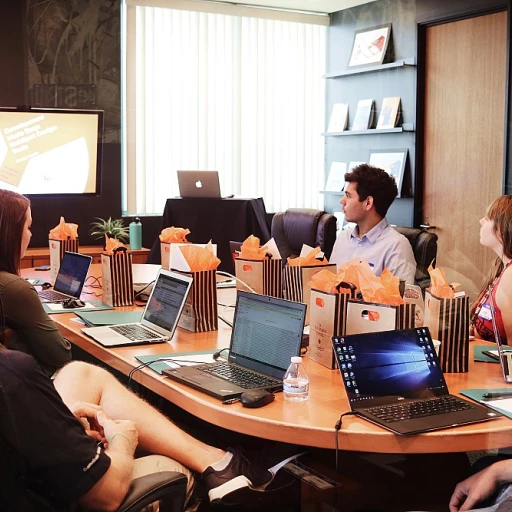
Understanding Toxicity in the Workplace
Recognizing a Harmful Work Culture
Understanding what constitutes a toxic work culture is critical for both employees and management. A toxic environment severely affects employee mental health and well-being, leading to issues like stress, burnout, and high turnover rates. Poor communication and a lack of team support often characterize these environments, which ultimately result in low morale and reduced productivity across the organization.
A toxic work environment can manifest in various forms, from subtle signs like team members feeling undervalued to more evident signs of a dysfunctional workplace. Employees may report feelings of being overwhelmed, unsupported, or stressed due to high levels of work pressure and a poor work-life balance.
The repercussions of such an environment ripple throughout the company, creating barriers to retaining top talent. It's essential to address these issues promptly, with human resources playing a pivotal role in identifying and mitigating the signs of toxicity in the workplace.
Engaging in positive office activities can help boost employee morale and counteract some toxic elements of a work environment. By fostering a healthier and more supportive culture, organizations can enhance overall productivity and employee satisfaction. To explore more about boosting morale and creating a positive workplace, consider integrating engaging office activities into your strategy. Engaging office activities provide a practical approach to uplifting the team spirit and nurturing a supportive work culture.
The Role of AI in Detecting Workplace Toxicity
The Power of AI in Recognizing Unwelcome Patterns
Artificial intelligence holds the potential to revolutionize how human resources identifies and addresses issues of workplace toxicity. Traditional management methods often fall short in detecting toxic environments and fail to protect employee mental health. AI comes into play by bringing a more analytic and unbiased approach to the table.
Machine learning algorithms can process large volumes of data and identify signs of toxicity that might be hidden from human observers, such as poor communication patterns, low morale, or increased reports of stress burnout. These insights empower HR to act promptly and effectively, ensuring a healthier work environment.
Advanced Techniques for AI-Powered Detection
One of the prime AI techniques used for diagnosing issues in the workplace is sentiment analysis. By evaluating various forms of communication, such as emails and chat logs, AI can detect signs of a toxic work culture. An enhanced employee experience can be achieved by identifying high levels of dissatisfaction or poor mental health markers, thereby paving the way for corrective measures.
Natural language processing (NLP) further assists in analyzing feedback from employee surveys and performance reviews. This allows HR teams to identify trends that indicate potential issues, such as a high turnover rate or feelings of isolation among team members. Such analysis can direct communication and support strategies in addressing these challenges, spotlighting areas requiring improvement.
7 Key Indicators of a Toxic Work Environment
Pervasive Lack of Support
One of the most obvious signs of a toxic work environment is the consistent lack of support for employees. In a healthy workplace culture, team members feel encouraged and backed by their peers and management. When the opposite is true, workers might experience low morale and high levels of stress. Employees may find it challenging to complete tasks when they perceive they are isolated or unsupported, ultimately affecting their mental health and work life balance.Poor Communication Practices
Effective communication is vital for any organization, and its absence can be a warning sign of toxicity. In environments where poor communication pervades, employees often struggle to collaborate and convey their thoughts effectively. Misunderstandings are frequent, leading to mistrust and frustration among team members. Such environments can hurt the mental health of employees, causing further issues in team dynamics and project deliveries.Constant High Turnover
An exceptionally high turnover rate may indicate more than a competitive job market. Consistent departures can reflect deep-seated issues in the work culture. Employees departing en masse could suggest dissatisfaction with management or the work environment itself. Human resources should investigate the underlying causes of high turnover, as retaining top talent is crucial for sustaining company growth and morale.Chronic Overwork and Burnout
When employees regularly feel overwhelmed by unreasonable workloads, the risk of stress burnout escalates. A persistent demand for overtime signals a work environment lacking in respect for personal time and mental health. Overworked employees not only underperform but also contribute to a cumulative decline in overall team efficiency.Exclusion from Decision-Making
Disregarding employee input on decisions can contribute to a toxic environment. Workers who feel their opinions and insights are not valued experience low morale and disengagement. When management frequently excludes staff from shaping the direction of their projects, it inadvertently signals a lack of trust in their capabilities.Inflexible Working Conditions
Rigid work practices that offer no room for accommodating personal needs can be detrimental to maintaining a balanced work life. In an era advocating for mental health and well-being, clinging to outdated, inflexible practices breeds resentment and frustration among employees.Lack of Recognition and Appreciation
Finally, a workplace where employees rarely receive acknowledgment for their contributions fosters resentment. Companies that do not prioritize recognition can miss opportunities to increase morale and engagement. Crafting heartfelt messages for employee appreciation can be a simple yet effective way to combat signs of a toxic work environment. For insights on how to implement this strategy, consider reading this guide on crafting heartfelt messages. Addressing these red flags with the help of AI tools can assist in creating healthier, more supportive work environments. Deploying the right strategies and technologies ensures that employees feel valued and heard.AI Tools for Monitoring Employee Sentiment
Leveraging AI for Employee Sentiment Monitoring
AI tools are transforming how organizations monitor employee sentiment, crucial in identifying destructive dynamics in a toxic work environment. Through advanced algorithms, these tools can detect patterns and signals indicative of workplace issues. This proactive approach helps HR teams intervene before minor frustrations evolve into high levels of stress burnout, low morale, or a high turnover rate. AI analyzes vast amounts of data, from internal communication platforms to employee reports, to spot signs of a potentially toxic environment. It's designed to understand the nuances of employee interactions and feedback, highlighting areas where communication might be poor or where employees feel unsupported, allowing management to act accordingly. The benefits of AI tools in sentiment analysis include:- Real-time Insights: AI provides continuous monitoring, offering up-to-date insights into the health of work culture.
- Objective Analysis: AI reduces bias in assessing employee sentiment, helping identify issues like lack of support or poor communication objectively.
- Predictive Capabilities: By recognizing negative trends early, AI assists in proactively addressing them, avoiding high turnover rates.
Implementing AI Solutions in HR Practices
Embracing AI in Human Resources
Incorporating AI into human resources practices can significantly enhance a company's ability to identify and address signs of a toxic work environment. Early detection of such issues can prevent significant issues like high turnover, low morale, and stress burnout, ultimately supporting the mental health of everyone involved.
AI-Powered Solutions for HR
AI tools are no longer a futuristic concept but a tangible reality in identifying a toxic workplace culture. These solutions are adept at picking up on signs toxic environments might present, including poor communication and high levels of absenteeism. By analyzing patterns and trends at the workplace, AI can pinpoint areas requiring immediate attention.
Streamlining Reporting Systems
Human resources can implement AI-driven platforms that allow employees to safely speak their truth without fear of retaliation. This ensures that employee feedback is both collected and acted upon in real-time, creating a supportive workplace environment. Vigilant reporting systems could also highlight recurring issues that lead to a progressively toxic work atmosphere.
AI in Managing Employee Sentiment
AI solutions offer dynamic analytics and save valuable time through automated sentiment analysis. Management can track employee sentiment over time, identifying patterns of behavior or mood that might be associated with poor mental health or workplace dissatisfaction. Such insights enable HR to tailor their strategies to support a healthier work-life balance.
Cultivating Management Insight and Decision-Making
With data-driven insights from AI, management can make informed decisions regarding the work environment and employee well-being. Understanding how employees feel about their interactions with team members and overall company culture can guide strategic changes, fostering a more positive and less toxic environment in the long run.
Future Trends: AI and Workplace Culture
Integrating AI-Driven Insights into Work Culture
As we navigate the swift currents of technological advancement, the prospect of using AI to shape a healthier work environment is becoming increasingly feasible. Human resources teams are beginning to understand the profound impact AI can have on workplace culture, particularly in spotting signs of toxic dynamics and enabling corrective measures. Companies are recognizing the need for a shift toward more data-driven decision-making that holds the potential to improve not just operational efficiency, but also employee well-being.
Integrating AI solutions into workplace practices isn't merely about automating tasks. It represents a shift towards creating environments where toxic work conditions are identified swiftly and addressed proactively. Here, AI serves as a support system in building a nurturing environment where the mental health of team members is prioritized, and signs of poor communication and low morale are promptly detected.
Shaping a Proactive HR Strategy
HR divisions leveraging AI tools help to craft a more inclusive and safe space for employees. By continuously analyzing data related to employee interactions, AI provides insights that can inform strategies aimed at reducing stress, preventing burnout, and ultimately curbing the high turnover rates that plague many organizations. It's a step towards ensuring that any reports of toxic work culture are addressed effectively, fostering a positive environment where top talent feels valued and supported.
The integration of AI into HR processes also allows for the enhancement of communication channels between team members and management, reducing the probability of a toxic environment developing in the first place. AI can facilitate real-time feedback mechanisms, catering to the dynamic nature of human interactions in the workplace, and providing managers with the insights they need to take timely action.
Elevating Future Work Environments
Looking ahead, as more companies embrace AI-driven solutions, the expectation is that work life and life balance in workplaces will see marked improvement. The tools that analyze workplace sentiment will become increasingly sophisticated, allowing organizations to minimize signs of a toxic workplace proactively. Organizations will see enhanced support for mental health initiatives, be better equipped to identify stress points, and create a cultural blueprint for a healthier, more supportive work environment.
In conclusion, while the challenges of managing toxic work environments persist, the promising role of AI in reshaping workplace culture is undeniable. As we transition into more advanced AI applications, the hope is to witness not just a decline in environments described as toxic, but a significant boost in employee satisfaction and company morale overall.












